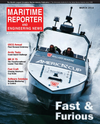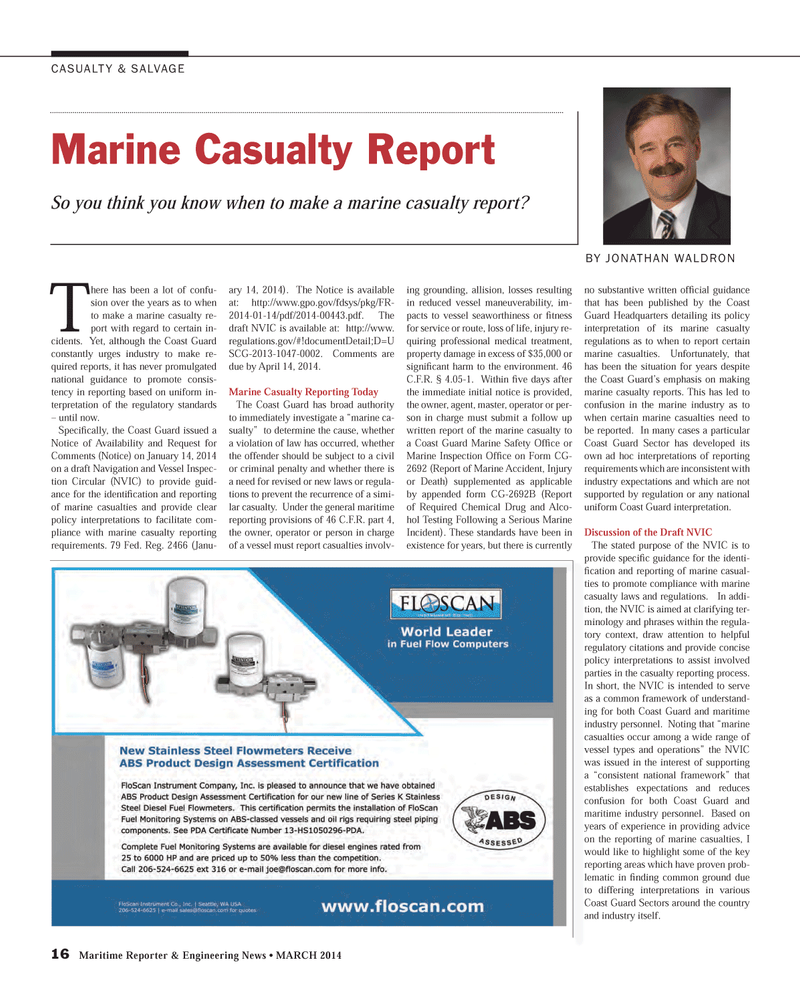
Page 16: of Maritime Reporter Magazine (March 2014)
U.S. Coast Guard Annual
Read this page in Pdf, Flash or Html5 edition of March 2014 Maritime Reporter Magazine
16 Maritime Reporter & Engineering News • MARCH 2014
CASUALTY & SALVAGE
T here has been a lot of confu- sion over the years as to when to make a marine casualty re- port with regard to certain in- cidents. Yet, although the Coast Guard constantly urges industry to make re- quired reports, it has never promulgated national guidance to promote consis- tency in reporting based on uniform in- terpretation of the regulatory standards – until now.
Specifi cally, the Coast Guard issued a
Notice of Availability and Request for
Comments (Notice) on January 14, 2014 on a draft Navigation and Vessel Inspec- tion Circular (NVIC) to provide guid- ance for the identifi cation and reporting of marine casualties and provide clear policy interpretations to facilitate com- pliance with marine casualty reporting requirements. 79 Fed. Reg. 2466 (Janu- ary 14, 2014). The Notice is available at: http://www.gpo.gov/fdsys/pkg/FR- 2014-01-14/pdf/2014-00443.pdf. The draft NVIC is available at: http://www. regulations.gov/#!documentDetail;D=U
SCG-2013-1047-0002. Comments are due by April 14, 2014.
Marine Casualty Reporting Today
The Coast Guard has broad authority to immediately investigate a “marine ca- sualty” to determine the cause, whether a violation of law has occurred, whether the offender should be subject to a civil or criminal penalty and whether there is a need for revised or new laws or regula- tions to prevent the recurrence of a simi- lar casualty. Under the general maritime reporting provisions of 46 C.F.R. part 4, the owner, operator or person in charge of a vessel must report casualties involv- ing grounding, allision, losses resulting in reduced vessel maneuverability, im- pacts to vessel seaworthiness or fi tness for service or route, loss of life, injury re- quiring professional medical treatment, property damage in excess of $35,000 or signifi cant harm to the environment. 46
C.F.R. § 4.05-1. Within fi ve days after the immediate initial notice is provided, the owner, agent, master, operator or per- son in charge must submit a follow up written report of the marine casualty to a Coast Guard Marine Safety Offi ce or
Marine Inspection Offi ce on Form CG- 2692 (Report of Marine Accident, Injury or Death) supplemented as applicable by appended form CG-2692B (Report of Required Chemical Drug and Alco- hol Testing Following a Serious Marine
Incident). These standards have been in existence for years, but there is currently no substantive written offi cial guidance that has been published by the Coast
Guard Headquarters detailing its policy interpretation of its marine casualty regulations as to when to report certain marine casualties. Unfortunately, that has been the situation for years despite the Coast Guard’s emphasis on making marine casualty reports. This has led to confusion in the marine industry as to when certain marine casualties need to be reported. In many cases a particular
Coast Guard Sector has developed its own ad hoc interpretations of reporting requirements which are inconsistent with industry expectations and which are not supported by regulation or any national uniform Coast Guard interpretation.
Discussion of the Draft NVIC
The stated purpose of the NVIC is to provide specifi c guidance for the identi- fi cation and reporting of marine casual- ties to promote compliance with marine casualty laws and regulations. In addi- tion, the NVIC is aimed at clarifying ter- minology and phrases within the regula- tory context, draw attention to helpful regulatory citations and provide concise policy interpretations to assist involved parties in the casualty reporting process.
In short, the NVIC is intended to serve as a common framework of understand- ing for both Coast Guard and maritime industry personnel. Noting that “marine casualties occur among a wide range of vessel types and operations” the NVIC was issued in the interest of supporting a “consistent national framework” that establishes expectations and reduces confusion for both Coast Guard and maritime industry personnel. Based on years of experience in providing advice on the reporting of marine casualties, I would like to highlight some of the key reporting areas which have proven prob- lematic in fi nding common ground due to differing interpretations in various
Coast Guard Sectors around the country and industry itself.
Marine Casualty Report
So you think you know when to make a marine casualty report?
BY JONATHAN WALDRON p t c t m t r p p
I a i i c v w a e c m y o w r l t
C a
MR #3 (10-17).indd 16 3/4/2014 12:12:42 PM

 15
15

 17
17
